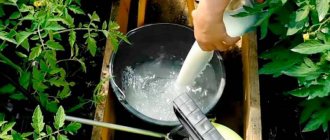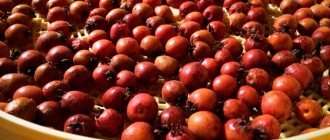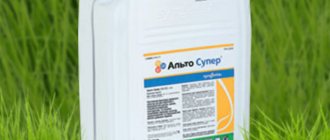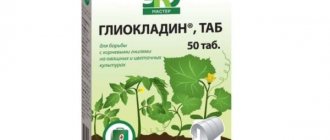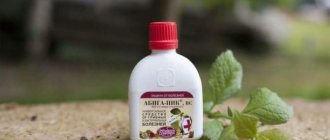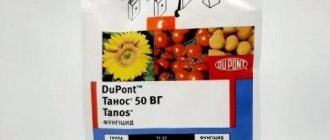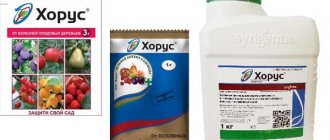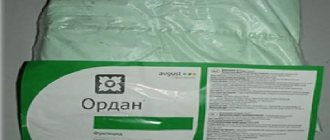The action of the fungicide Fitolavin
At its core, Fitolavin is an antibiotic that belongs to the category of both systemic and contact fungicides of biological origin.
This is more of a medicinal drug, although it is good as a preventative measure. Phytolavin quickly suppresses the activity of fungi and other pathogenic microorganisms that can attack plants and harm them.
The main bactericidal effect is exerted by phytobacteriomycin. In terms of its chemical “influence” it is equal to biomycin and streptomycin.
Use of the drug
“Fitolavin” must be used for seedlings for preventive purposes, and subsequently nourish the plants to avoid their rotting. This should be done with a break of 14 days, but no more than 2 times. For example, for apple bacterial burn and moniliosis, it is necessary to carry out 5 procedures, taking a break of two weeks.
Having bought home flowers, especially orchids, they must be completely processed, as they can be infected with tracheomycosis (drying). An alternative for treating orchids is Fundazol. If there are primary signs of fungus on stems or roots, it is necessary to spray the plant and water the soil around it.
"Fitolavin" must be used for seedlings for preventive purposes
The medicine in tank containers can be combined with various insecticides, fungicides and herbicides. However, it should not be diluted with bactericidal drugs. Streptomycin antibiotics are very toxic, so you need to work with such substances with extreme caution.
Advantages and disadvantages
The drug Fitolavin has its advantages and disadvantages.
Among the advantages:
- the necessary disinfectants enter the plants quickly enough, and therefore within 10 hours after using Fitolavin the result is noticeable;
- beneficial insects are not harmed by the use of the drug;
- broad spectrum of action, that is, the substance copes well with most fungi and bacteria;
- At the moment, Fitolavin is the only officially approved antibiotic for use on any plant crops;
- after preventive treatment, the plantings are guaranteed to be protected for a long time;
- application for planting material;
- affordable price Fitolavina.
Photo of the drug Fitolavin
Disadvantages of Fitolavin:
- may harm bees within 12 hours after treatment;
- does not work in alkaline environment.
Bottom line
The Russian drug Fitolavin is widely used in homestead farming and agricultural complexes. Low cost and high efficiency of application made it attractive in the eyes of farmers. What makes the drug more attractive is its safety for humans and domestic animals, as well as its relative harmlessness to bees and water inhabitants.
The only drawback of the drug is that it does not work on neglected areas. Fitolavin exhibits its activity as a preventive drug, and it is also effective for the treatment of fresh diseases with phytofungi. But at the initial stage of plant infection, it is more preferable than potent drugs. However, it has the ability to accumulate in the soil, which contributes to the habituation of microorganisms and the emergence of resistance.
The attractiveness of the drug was ensured by the fact that the yield on the site increased after application. Crops begin to actively grow and develop, fruiting increases, and the taste of the fruit improves.
Release form
As already mentioned, the drug can be used for both large-scale agriculture and household use.
In this regard, the manufacturer has provided several forms of release of the fungicide Fitolavin for each individual species:
- 2 ml in small ampoules, which is very convenient for use at home or in a small garden plot;
- bottles with a capacity of 50, 100, 400 ml. This is the best option for garden plots with a small area;
- in canisters of 1 or 5 liters - this is the optimal and economical option for large farms, because it is much more profitable for them to buy the Fitolavin fungicide in such a volume.
Indications for use
The range of applications of Fitolavin is quite wide:
- bacterial rot;
- root neck rot;
- bacterial cancer;
- burns;
- blackleg;
- leaf spot;
- root rot;
- stem necrosis;
- black spot;
- moniliosis;
- Alternaria blight.
Fitolavin: instructions for use for plants
When carrying out work, you must carefully observe all the drug consumption rates specified in the instructions in each individual case.
The use of a fungicide is permitted at any stage of crop development, from the seed stage to fruit harvesting
. You can spray and soak at the seedling stage in a freshly prepared solution. And so, when the disease is first detected, it is necessary to immediately begin treatment.
Attention!
During treatment, when the plant is damaged, it is necessary to spray the soil with Fitolavin.
Photo instructions for use from the manufacturer
Treatment time with Fitolavin
The fungicide is used according to a certain scheme so that the substance does not accumulate in fruits and in the soil. In one season you can do no more than 5 treatments. And the drug is used twice every 30 days, making sure to observe the same intervals.
Every year it is recommended to use the drug Fitolavin only when the plants are regularly sick
. If such systematic treatment is necessary, then take longer breaks in use, equal to 30-60 days, based on the advanced state of the disease.
When the plants do not get sick for a couple of years or longer, there is no need to use the product next year. Prevention is required when plants in a nearby area are sick.
Fitolavin. Useful tips for summer residents - video
Properties of the drug
"Fitolavin" has the following characteristics:
- does not harm insects (with moderate dosage);
- for prevention, you can treat the seeds;
- the acidity of the mixture can be any, but the pH value should be no more than 9;
- quickly eliminates problems, penetrating deeply into the plant (action time - from 12 hours to 1 day);
- provides protection for stems and fruits for 14–25 days and accelerates their growth.
Expert opinion about phytoavalanche:
An effective drug aimed at treating fungal and bacterial infections of plants. Includes a sulfonamide drug, antibacterial - streptocide. It has excellent compatibility with fungicidal and insecticidal agents. Suitable for use in tank mixtures. Used for the prevention of mycotic-bacterial diseases, as an emergency aid for infected specimens.
Anatoly Baykov
For which plants is Fitolavin suitable?
The list of crops that can be treated with Fitolavin is quite large:
- fruit trees;
- vegetables;
- berries;
- cereals;
- ornamental plants (often used for processing orchids: tubers, seedlings, seeds).
Fitolavin: consumption rate and dosage
To obtain a positive protective effect, it is worth knowing how and in what quantities to dilute Fitolavin
.
Usually this is a standard dosage of 2 ml per 1 liter of water
. Some crops may require a higher concentration.
This is always specified in the instructions for use of Fitolavin. For example, to treat a potato crop you will need a much larger amount of the drug in the amount of 20 to 50 ml per 10 liters of water.
Attention!
The Fitolavin solution prepared for spraying must be of uniform consistency and used exclusively fresh.
FUNGICIDES:
Fungicide Acrobat MC Fungicide Horus Fungicide Azophos
Consumption rates Fitolavina:
- seedlings: from 30 to 45 ml for each seedling;
- shrubs - from 1.5 to 2 liters per planting;
- trees - from 3 to 5 liters;
- vegetables and grains:
20 liters per 100 m2.
To treat indoor plants or vegetation in the garden with Fitolavin, you will need from 210 to 220 ml, and for small flowers - from 100 to 110 ml.
Fitolavin - WHAT IS IT? - video
Description and chemical composition of the product
The action of Fitolavin is based on the antibiotics of the streptothricin group included in the drug. These are naturally occurring substances called phytobacteriomycin (PTM). They affect pathogens, blocking their development, and also weakly inhibit soil bacteria.
On a note! To restore the microflora in the soil after treatment with Fitolavin, additional EM preparations are added.
The concentration of PTM in the biobactericide solution is 32 grams per liter. The main effect is the suppression of protein synthesis of pathogenic bacteria, disruption of the correct genetic coding of infectious agents. The components of the product quickly penetrate plant tissue (waiting up to a day), ensuring the death of bacteria and a number of fungi. Protection – up to 18-20 days.
Indications for use
Fitolavin is used as a preventive and therapeutic agent in summer cottages and on farms. The range of diseases for which the drug is effective is large:
- various types of rot (root collar, root, apical, soft bacterial, dry);
- Alternaria blight;
- blackleg;
- necrosis;
- black, angular spotting;
- bacterial burn;
- bacterial cancer;
- moniliosis;
- bacterial wilt;
- tracheomycosis.
The product is not harmful to pollinators.
What plants is it suitable for?
Fitolavin is recommended for most plantings of annual and perennial crops. Used on mature trees, seedlings, berry bushes, seeds, seedlings, and vegetables.
Suitable for processing:
- tomatoes, cucumbers in beds and in greenhouses;
- berries;
- fruit crops;
- potatoes;
- cereals;
- roses (garden and home);
- indoor plants of the bromeliad family;
- orchids.
To prevent diseases, spray all above-ground parts of plants with the prepared solution. When treating infections, the soil around the plantings is additionally irrigated. When treating indoor flowers, in addition to spraying the leaves and shoots, moisten the soil in the pots.
Methods of treatment with Fitolavin
There are several ways to treat with Phytolavin, in particular, spraying and watering, soaking seeds. Ideal for tuber "bathing".
Spraying
As a preventative measure, it is sufficient to spray the outer parts of the plant with a solution of Fitolavin from a spray bottle.
The frequency of spraying is as follows:
- first treatment – at the stage of bud formation;
- the second - during the flowering period;
- the third - after the ovaries have already formed;
- fourth - when the fruit size is 3-4 cm.
Especially weakened, diseased plants require complex treatment. They require both spraying and soil treatment nearby.
Watering
Soil moisture goes down to the root.
The use of Phytolavin under the root is as follows:
- seedlings of tomatoes, cucumbers - 50 ml at the stage of 3 formed green leaves;
- 14 days after planting in a permanent place of growth - increase to 100 ml.
Watering with Fitolavin is good both as a preventive measure and when rot appears, which is often caused by excessive soil moisture.
Pests in the garden!
Leaf roller How to deal with cutworm How to get rid of wireworm
Soak
Soaking the seed requires 2 hours or more. This measure reduces the likelihood of root rot or bacterial rot (soft), as well as stem necrosis.
Seed dressing
There are two options for treating planting material:
aerosol spraying and soaking in a prepared solution.
How to use
Before use, you must prepare a 0.2% working solution:
- Fill a 10-liter bucket with clean water.
- Add 20 ml of concentrate.
- Stir until smooth.
The solution loses its fungicidal properties within 12 hours.
Therefore, it is prepared immediately before use. Expert opinion
Chernyaeva Tatyana Dmitrievna
Absolutely loves gardening and grows only organic vegetables
Ask a Question
The drug remains effective in an environment of any acidity, except highly alkaline (pH above 8.5).
How to take into account features for different cultures
Regardless of the severity of the disease and the type of application, a 0.2% solution is used for treatment. Increasing the concentration can be detrimental to the plant.
Depending on the location of the disease, the drug is used in one of the following ways:
- Spraying.
- Watering.
- Soil irrigation.
- Soaking tubers and seeds (as pre-sowing preparation).
| Culture | Application technique | Dosage |
| Cucumbers and tomatoes | Watering (for diseases of the root system) and spraying. The first treatment is carried out 7 days after planting, the second – 21 days after the first (for tomatoes, 2 treatments are performed with an interval of 2 weeks). The seedlings are processed only after the third true leaf has unfolded. | 100 ml/bush, for seedlings – 50 ml. For ground tomatoes - 10 liters/1 hundred square meters |
| Potato | Treating tubers before planting and spraying: 1st treatment - during budding, 2nd treatment - 3 weeks after the first. | 100 ml/bush |
| Fruit trees | Spraying. Performed in stages: 1) during budding; 2) at the beginning of flowering; 3) during the formation of ovaries; 4) when fruits with a diameter of 3-5 cm are formed. | 3-5 liters/1 tree |
| Shrubs | Spray twice in early spring with an interval of 2-3 weeks. | 1-2 liters/1 bush |
| Indoor flowers | Watering to treat bacteriosis. Spraying the soil and leaves. | 100-220 ml/1 flower |
| Cereals | Spray as needed. | Up to 20 liters/1 weave |
Precautions when processing plants
Despite the non-toxicity of Fitolavin (hazard class 3),
It is still necessary to observe basic protective measures and wear at least gloves, goggles, and protect the respiratory tract with a bandage. The drug should not be allowed to get on mucous membranes or inside.
The best time to treat plants with Fitolavin is
in the evening, when there is no strong wind.
It's better to have no wind at all. When processing will take place in greenhouse conditions, it is recommended to wear a raincoat or disposable robe over clothing. This is necessary due to the warm atmosphere in the greenhouse, which only enhances the effect of the substance on the human body. The processing process must be continuous. After completion, you must thoroughly wash your hands and rinse your mouth.
Attention!
Once again, it is worth noting for beekeepers that when there are bees near them, they should not be allowed to plant for 12 hours after treatment; Fitolavin is toxic to them.
However, during the treatment process, it may also happen that the drug ends up on the surface of the skin or even gets inside.
Fitolavin against BACTERIOSIS. REMEDY FOR BUSH WILLING - video
What to do in such cases:
- eyes and skin are thoroughly washed with water;
- if ingested, drink as much liquid as possible to induce vomiting, take activated charcoal, consult a doctor;
- In any case, you need to be careful with the product.
Plant diseases:
Gray rot on vegetables, fruits and flowers Mosaic virus Powdery mildew
Compatibility of Fitolavin with other drugs
Fitolavin is well compatible with other drugs that help eliminate existing diseases or prevent their occurrence. It can be perfectly combined with most fertilizers, with approximately 85% of the total. Among them are the same fungicides, insecticides, and herbicides.
Attention!
There is only one contraindication when Fitolavin cannot be used with bacterial agents such as Gamair, Tsidoks, Lepidotsid. The reason for this is a significant reduction in the effectiveness of each drug when used together.
Phytolavin for orchids before transplanting phalaenopsis - video
Other biofungicides and their features
Rotten orchid roots can be cut off and the plant can be kept in the Fitolavina solution for 10 minutes, after which it can be planted in a fresh substrate.
There are many biofungicides on the shelves of gardening centers that are highly effective in combating fungal infections of plants. Among them are the following:
- "Trichodermin." Contains spores of the fungus Trichoderma viride. Once in the soil, they germinate and begin to secrete waste products that are destructive to pathogenic flora. Unlike “Fitolavin”, it is more effective as a preventive rather than a therapeutic agent (see → Trichodermin: instructions for use, waiting period, how to dilute and process).
- "Pseudobacterin-2". Contains a live culture of the bacterium Pseudomonas aureofaciens. Works well against both fungal and bacterial infections. Like Fitolavin, it has a growth-stimulating effect.
- "Mycoplant". Contains spores of mycorrhizal fungi of the genus Glomus, which colonize the soil. In addition to fungicidal activity, it has the ability to improve humus formation in the soil.
The group of biological fungicides also includes such products as “Fitosporin-M” → how to use the protective drug, “Gamair” → instructions for use + reviews, “Baktofit” → how to dilute and use, “Alirin-B” → how to use the fungicide, “ Gaupsin", "Planriz" → how to use + reviews. The advantageous difference between “Fitolavin” and most of the listed products is its systematic action, which allows the substance to work not only on the surface or in the substrate, but also in the deep layers of plant tissue.
Fitolavin's analogs
There are several Fitolavin substitutes that also work well against fungus and pathogenic bacteria.
Analogues of Fitolavin:
- Alerin-B
fights root rot and blackleg. - Gamair
is ideal for eliminating necrosis, cancerous formations, and eliminating burns of a bacterial nature. - Baktofit
helps with most bacterial infections. - Kasugamycin
has an antifungal effect and is used for prevention and treatment. - Kazumin
is a biological product against harmful bacteria. - Skor
is an excellent prevention and treatment of plants at any stage of development.
Another worthy analogue of the drug Fitolavin is Fitosporin.
Which is better: Fitolavin or Fitosporin
Main differences:
- Fitolavin is produced only in one form - a concentrate, soluble in water, and Fitosporin - in the form of a paste, liquid, powder;
- Fitolavin acts longer and is a chemical preparation containing an antibiotic, and Fitosporin is a completely biological agent;
- the cost of Fitolavin is 102 rubles, while Fitosporin is 27-28 per package.
It is worth trying both drugs, because it is impossible to say for sure which is better.
Correct use of phytoverm, pharmaiod, phytolavin for protection against diseases and pests - video
Storage conditions
To preserve the properties of the drug, it must be stored in a cool place where there is no sunlight at a temperature not exceeding +30 degrees. Children and animals should not be allowed into this place. Cannot be frozen.
Fitolavin is a fast-acting fungicide,
capable of quickly eliminating many plant diseases caused by fungi and other pathogenic microorganisms. This is the only antibiotic whose duration of action is 21 days.
Storage rules and expiration date
In order for Fitolavin to retain its properties, it is placed in a dry, dark place, at the maximum distance from food and medicines. The fungicide is stored at temperatures from 0 to +30°C. Freezing is unacceptable.
The inaccessibility of the biobactericide to children and pets should be monitored. The shelf life of the product is 12 months from the date of release.
Fitolavin is one of the drugs worthy of the attention of homeowners and agricultural workers. Due to its moderate cost and high efficiency, this product can be called one of the best modern antibiotics used in plant treatment. If you follow all the manufacturer’s recommendations, Fitolavin will provide reliable protection of vegetation from infections and will help increase the yield several times.
Fitolavin: reviews from summer residents about use
Vladimir Ivanovich, Vologda Treated apple trees with Fitolavin because the trees began to dry out and plaque formed on the leaves. After spraying, the effect appeared on the second day: the trees perked up, the leaves began to gain color. I now use it as a preventive measure.
Veronika Pavlovna, Krasnoyarsk Territory Last year, rot on the trunks appeared on blackcurrant bushes, and the leaves began to curl and turn yellow. I still didn’t understand the reason, it was necessary to urgently start processing. A friend recommended Fitolavin as a fast-acting remedy for various plant diseases. After a couple of days the bushes were healthy. Now this tool is always in my “arsenal”.
Tatyana Andreevna, Novosibirsk region I was extremely surprised when I noticed that the tomatoes on my plot began to wither. She always looked after it carefully: watered it in a timely manner, applied fertilizer, etc. Apparently some kind of fungus or something else. On the advice of the seller in the store, I took Fitolavin, sprayed the tomatoes with it, and everything returned to normal: the bushes began to come to life and, in my opinion, began to grow even better. Good product!
Reviews
Svetlana, Moscow. “For prevention, I spray all my plants with phytolavine. I treat sick orchids, which, say, without roots and with lost leaf turgor, 3 times a month. Orchids like it, roots begin to grow, leaves are restored. Naturally, if phytolavin no longer helps, then there are stronger drugs – foundationazole and phytosporin.”
Raisa, Kirov. “A wonderful product, completely natural. Helps against many diseases, and on any plants. It will help cope with tracheomycosis wilt in orchids and more. The spectrum of the drug is quite wide. You can water the plants and spray them. The effectiveness is amazing, of course, you need to have time to treat the plant before the point of no return from the other world comes.”
Alexey, Smolensk. “Natural antibiotic. I started using it at the dacha, on tomatoes and cucumbers. Then I tried it on house flowers. In principle, the drug can be used on all plants, at all stages of growth, starting from seeds and seedlings. I advise you to pay attention to it, since in any case you cannot do without chemistry. All “folk recipes” are ineffective and mostly useless nonsense.”
